Moonlight Gardens
This is the story of a Wigwam. Really.
Other names for this building at 729 Plymouth Ave. No. in Minneapolis were:
- Third Ward Republican Club
- Third Ward Theater
- Moonlight Gardens
- Citizens’ Protective League
- Moonlight Tavern
- Gay Paree
- Mickey’s Dine and Dance
THIRD WARD REPUBLICAN CLUB
Actually, it is the story of a building located at 729 Plymouth Ave No. in Minneapolis – the northeast corner of Plymouth and Aldrich Avenues. It was built in August 1902 by the Third Ward Republican Club – apparently these Republican clubhouses were called Wigwams.
The one-story building measured 44′ x 120′, with an auditorium capable of seating 850 people, a stage measuring 12′ by 35′, a kitchen, cloak rooms, two galleries, and apaarments for the janitor. The architect was Bertrand & Chamberlain, and it was built at a cost of $8,000. Ground was broken on August 7, 1902. The hall was dedicated in October 1902.
THIRD WARD THEATER
In 1911 the building was converted to a movie theater, Hennig Oswald, proprietor. The Minneapolis Tribune described it like this:
One enters this theater by ascending seven wooden steps. It has a seating capacity of 350; the size of the interior of the building is about 45 feet by 90. It gives four shows each weekday evening and six and seven shows on Sunday, the additional shows being given afternoons.
There are two double doors at the front of the building, one larg door opening on to Aldrich avenue, and no exit at the rear.
The two aisles are three and one half feet wide. The machine is operated over the box office at the front of the building and the booth is reached by ascending a flight of wooden steps from one side of the auditorium. The building is enirely of wood. The interior of the building gives the general impression of being roomy. Everything appears new and clean. It is heated by stoves. (Minneapolis Tribune, October 7, 1911)
How this building didn’t burn down is a mystery. Upon an inspection effort of theaters by the City, the Third Ward was required to add an another exit. The theater appeared to have lasted until about 1925.
MOONLIGHT GARDENS – DANCING AND ROLLER SKATING
In December 1925 we find advertisements for dances at Moonlight Garden, a dance hall. Another ad for a dance appeared in February 1926.
Then, on January 19, 1927, the building began to be used as a roller skating venue as well. The headline read, “Roller Skating Revived in City.” It was called the Moonlight Gardens Rink, operated by Harry Long. There was band music on Wednesday, Saturday, and Sunday nights. Longs wife, champion roller skater of the Northwest, gave exhibitions and offered lessons. The floor dimensions were given as 43′ by 90′.
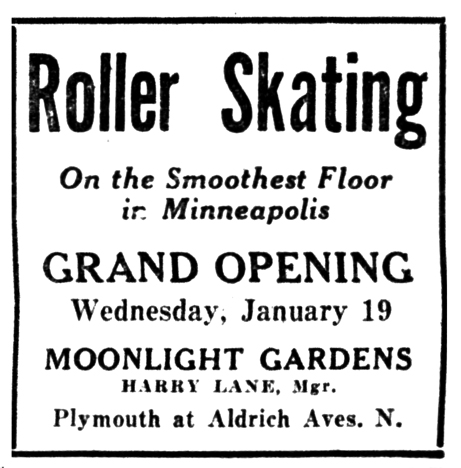
Minneapolis Tribune, January 18, 1927
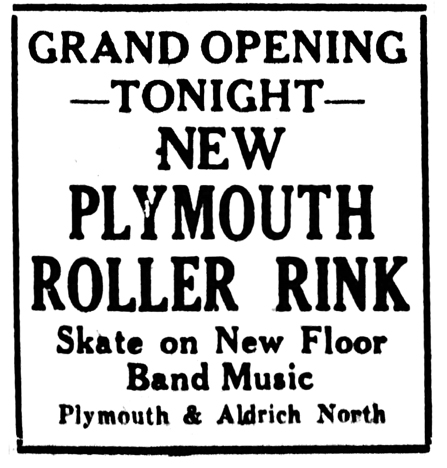
Minneapolis Tribune, September 24, 1927
CITIZENS’ PROTECTIVE LEAGUE
Dances must have stopped, because in April 1933, they started up again. 15 men who had been receiving unemployment assistance got together and fixed up the building and began to hold four dances each week in the building. Some of them played in the band and the rest worked on other chores. With the profits they helped the unemployed, especially truckers. They also collected clothes for families in need. (Minneapolis Star, April 4, 1933)
MOONLITE TAVERN
With the end of Prohibition in 1933, the Moonlight Gardens became the Moonlight (or Moonlite, as the ad says) Tavern. A New Year’s Eve WHOOPEE was planned for December 30, 1933, featuring four big floor shows with 37 Special Acts. “Dance to Jimmy Dunn and His Moonlight Stars Band into the Night. $1.00 per person, including noisemakers and New Years’ Breakfast.”
An ad showed that the owner sought to sell the building at the end of June 1934.
GAY PAREE
The Gay Paree was owned by Lester J. “Curlee” Elliott and Roy Olson. They owned it starting in about October 1934.
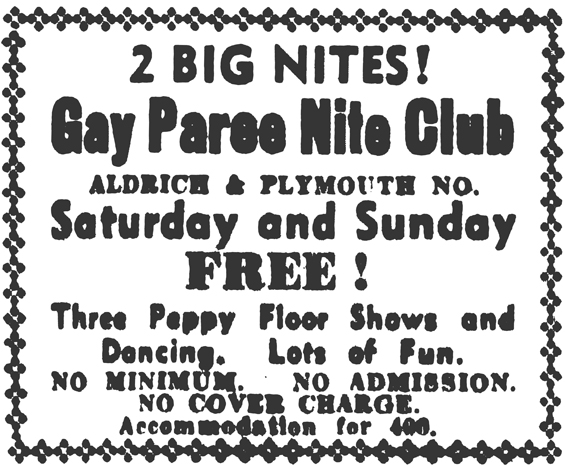
Minneapolis Tribune, November 24, 1934
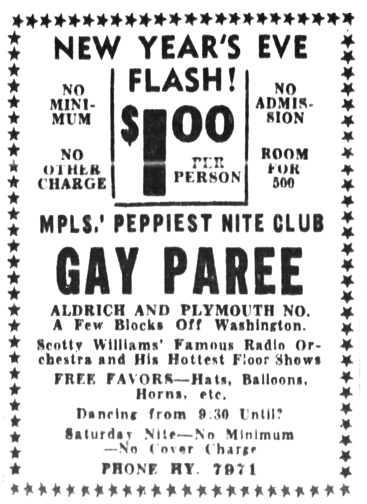
Minneapolis Tribune, December 29, 1934
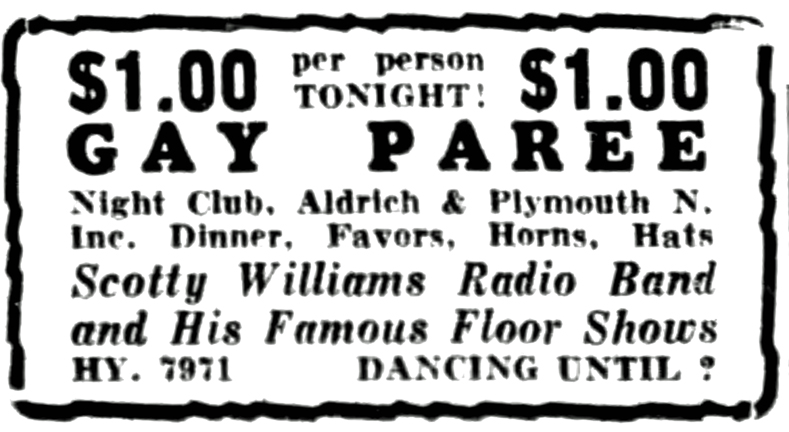
Minneapolis Star, December 31, 1934
On March 21, 1935, Curlee and Roy reported that “two masked, cursing bandits” invaded the night club and held up 15 employees, including members of the orchestra, coming away with $40 “loot.” Curlee had just left with the day’s receipts, and member’s of Frank Hines’ band saved their cash by dropping it on the floor. Roy got slapped for not moving fast enough.
Then it turns out that the whole robbery was a hoax, planned to be a cheap way to get publicity for the Gay Paree without paying for it. The police were not pleased, and neither was the judge: Curlee was sentenced to a $100 fine or 30 days in the workhouse for conspiracy to obstruct justice. Roy paid a fine of $25. And it looks like they lost their license as well.
MICKEY’S DINE AND DANCE
This barely merits a mention, since there was only one notice in the paper, looking for amateur performers in May 1935.
DANCING AND DRINKING DENIED
In August 1938, the City denied dance hall and tavern licenses to the place on the recommendation of the police. Another applicant, Albert Arbesfeld, was denied his request to transfer a 3.2 beer license from 2519 Plymouth Ave. to the place. No explanation was given, but it was inferred that the applicant was “fronting” for a well-known underworld character.
ROLLER SKATING CONTINUES
The name Rollaway Roller Rink appears just once, in March 1940. It’s unclear how long this activity lasted, but the building was advertised for sale in October 1940.
BANNER CANVAS CO.
The use of the building kind of disappears until August 4, 1966, when it was hit by a Molotov cocktail during the 1966 Northside riot. At that time it was the home of the Banner Canvas Co. The photo below gives us a hint of what the building looked like.
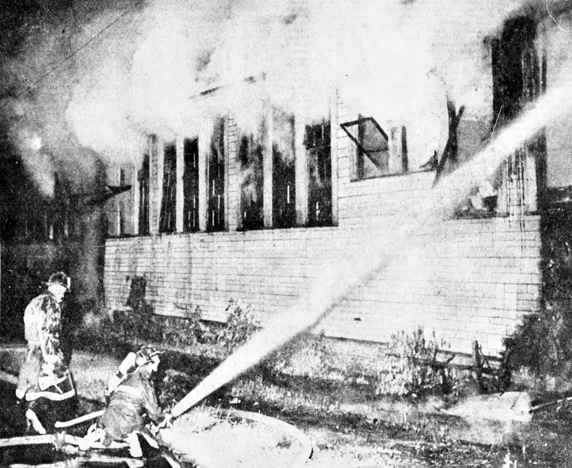
Minneapolis Star photo by Bob Schranck, August 4, 1966
DEMOLITION
The building was wrecked, probably because of fire damage, in March 1968.
